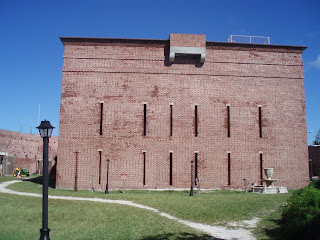Now that it's time* for this story to finally be told, check out the minifort on the opposite side of the island!
*Emily Elert's birthday. Happy birthday Emily!
View Larger Map
This thing is known as the 'East Martello', for a couple of reasons. It's 'east' because it's on the east side of the island (which is fine, I guess), and it's a 'martello' because people are stupid. Doubtless this revelation comes as a great shock- permit me to expound, with a...
Brief Digression on Historical Trends in Inexpensive Coastal Fort Designs
As you can imagine, forts are expensive. Building a serious military-grade piece of architecture takes a lot of time and money that is probably better spent on improving your domestic beef infrastructure. As a result, people across the world were always interested in the prospect of getting more bang-proof fort for less buck. In the 1500s, the Genovese fortified the island of Corsica with a bunch of little round towers that were much like Hobbes' view of life in mankind's natural state:

videlicet, solitary, poor, nasty, brutish, and short. However, these towers were also strong as the Dickens. The archetypal Martello fort (pictured above) is located at Mortella Point in Corsica ('mortella' translates as 'myrtle', by the by). It is in remarkably good shape considering it is half a millennia old. It is even more remarkable when you consider that during the 1794 Corsican campaign, it held out against two British men o' war (Fortitude, 74, and Juno, 32) and their marines for two days with only two casualties out of a garrison of 33. This was basically unprecedented and it so shocked Lord Hood, the commanding British admiral, that he talked everyone's ear off about it and incidentally introduced a misspelling that has persisted to this day. Pretty soon the entire British Empire adopted the design for strategic coastal defense and that led to most other countries copying the design themselves.

The basic idea of a Martello is pretty simple: round, with thick walls and a few guns on top mounted to shoot over the top of the wall (this is called a 'barbette' mounting, which sounds like a Mattel optional accessory, but there ya go). You'll notice that the Officer's Quarters and the Men's Quarters are the same size in the diagram above. Standard complement was 1 officer and 24 men. Hm. You'll also notice the parapet is set up to collect rainwater, obviating the need for an external supply. There is only one small door, which is set halfway up the side so you can pull the ladder up after you. All in all, a very efficient design.
Finis
Well, obviously, once I had got into all this history, it became apparent to me that Key West's East Martello was fundamentally misnamed. Yes, it did have a large tower in the center, but it was square, and had thin walls striped with loopholes that would not have stood up to a determined bombardment.

To make matters worse, this incorrect tower was surrounded by a perfectly normal tier of heavy cannon mounted in casemates (meaning the cannon fired out of holes in a wall instead of over the top of it). You can see the fort's layout below:
 Notice they're calling the central tower a 'citadel', which, come on guys, is getting a little carried away. This thing was so poorly constructed that the weight of the cannon eventually caused the roof of the tower to collapse. Gravity! The one foe they didn't count on having to face! Anyway, here's a shot of the outer wall.
Notice they're calling the central tower a 'citadel', which, come on guys, is getting a little carried away. This thing was so poorly constructed that the weight of the cannon eventually caused the roof of the tower to collapse. Gravity! The one foe they didn't count on having to face! Anyway, here's a shot of the outer wall.
You've doubtless noticed those thick cast-iron 'throats' set into each gunport- designed by an American general name of Totten, these were intended to reinforce these weak points (which were, after all, holes in the wall) and allow metal shutters to be installed to protect the gun crews from snipers while they were reloading. This was a big deal back in the 1850s. Totten was kind of a baller. Remember that name.
Anyway, I'm sure there is a word for this type of fort but 'martello' definitely ain't it. Don't worry- I already fixed the Wikipedia entry. I recommend you bring your relative who is really into building paper models to this fort so they can later find this hot little number and send it to you:
 Adorable!
Adorable!
No comments:
Post a Comment